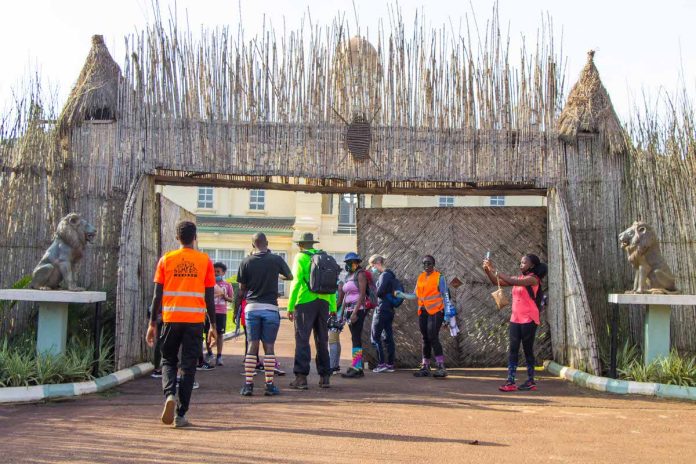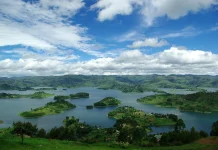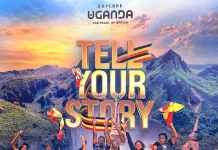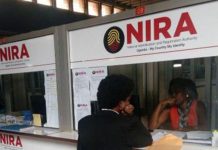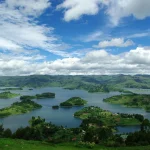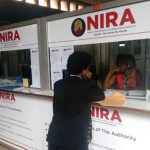The Kabaka’s trail offers an opportunity to explore the Buganda cultural sites that highlight Buganda’s rich history and cultural heritage. This can be experienced through storytelling, music, dance, museum, food and traditional herbal medicine. The Kabaka’s trail comprises seven cultural sites all located within Kampala.
Other places you might visit on this tour are historical buildings, Nakasero and Owino markets, Kabaka’s Palace, and lake at Mengo hill.The Buganda kingdom has been in existence for several centuries. The kingdom has been led by 36 kings with the current king being Kabaka Ronald Muwenda Mutebi II. The king heads all developmental activities in the kingdom like social, health, education, economic and cultural aspects. The trail might last for a day depending on the choice of sites and the time spent at each site. Those not ready to trail can use the preferred means of transport such as a boda–boda or taxi tour to get around.
Sites on Kabaka’s trail
Nagalabi- Buddo hill
Naggalabi coronation site is located in Buddo Wakiso district along Kampala- Masaka highway. The hill has been a traditional venue for the coronation of the Buganda kings since the 14th century. This historical site symbolizes the beginning of kingship in Buganda. The history dates back to the victory of king Kintu over Bemba Musota. According to buganda.or.ug website, Kintu and Bemba were brothers. Bemba lived in a house called Buganda at Naggalabi Buddo.
When Kintu who originated from the northeast region arrived, he conquered the area and defeated the indigenous leader Bemba Musota in battle of Ssemanobe. After the battle Kintu slept in Bemba’s house as a sign of victory. He later ordered the new clans to intermarry with the indigenous people creating the Buganda Ethnic group. Nagalabi hill has served as a venue for the coronation of kabaka Ronald Muwenda Mutebi II on 31st July 1993.
The hill also features different landmarks for instance; Nakibuuka forest locally referred to as Akabira Nakibuuka where Bemba met his death. This is also where the last and most important coronations rituals are performed. The newly crowned kings always spend nine days in this place contemplating with their cabinet. The Mboneredde tree which acted as the traditional court during the reign of Kabaka Kintu. There is also a Buganda house locally known as akayumba Buganda.
Katereke prison ditch

The site is located 40 minutes away from Kampala city 1.5 km off Masaka road opposite Nsangi police station. The Katereke prison ditch was dug by king Kalema in the 19th century. This period was identified as demented and brutal in the Buganda kingdom. In 1888 the kingdom was in political confusion as the people who claimed to be muslims overthrew Kabaka Mwanga and succeeded him with king Kiwewa. He also lived a short life and was replaced by king Kalema. However king Kalema was not comfortable with leadership, he was threatened by his siblings. To overcome this he ordered the clan men to construct the prison and he imprisoned all his siblings and later had them slaughtered. The ditch is not too deep and the circle is 70 meters in diameter.
Wamala tombs site on Kabaka’s trail
The tombs are located 30 mins drive from Kampala city in Nansana- Nabweru subcounty Wakiso along Hoima road. The Wamala tombs serve as the final resting place of the 29th king of Buganda Ssekabaka Suuna II. Kabaka Suuna was a son of Kabaka Kamanya. He ruled from 1836 to 1856 but he was very detective and powerful. During his reign he conquered the counties of Buyaga and Bugangayizi counties. Suuna had 218 children from 148 women and he was the last king to have his jaw bone removed and to be buried in this place. Previously in Buganda when the king died they used to remove his jaw and put it in a royal sanctum that is served by their subjects. These jaws were believed to have their spirits.
These tombs are built in African architecture with grass thatched roof at Wamunyenye hill. The road to the top of the hill is lined with filtering stones. The visitors explore artifacts like shields and spears which are said to guard the cloth believed to protect the forest where he went to live a new life. Also the tombs protect the Kabaka’s dead twins’ umbilical cords. The Buganda kingdom takes this place as a sacred site. They hold traditional rituals and ceremonies in this place as a way of communicating to their ancestors. The Baganda are also fond of making sacrifices to the king and other people who were buried in these tombs.
Namasole Kanyange cultural center
The cultural center is located 12 km away from Kampala city center along Bombo road in Kagoma trading center. The Kanyange tombs overlook the Wamala tombs. Namasole Kanyange was a mother to Kabaka Suuna II. Namasole is a title given to the mother of a king in Buganda but Kanyange was a daughter to Sambwa Katende and a wife to Ssekabaka Kamanya.
Kanyange is said to be one of the prettiest, respected, most admired and powerful women in the Buganda kingdom by then. Among the Buganda kings, king Suuna loved his mother so much. When he was crowned to the throne he ordered the construction of a comfortable place for his mother that is near to his residential palace. It is believed that the king did this so as to keep a close eye to his mother.
Namasole Baagalayaze tombs
These are burial grounds of Namasole Baagalayaze, a wife to kabaka Mutesa I and a mother to kabaka Mwanga II who passed away in 1916. Her name was Queen Namasole Abisagi Nakatya but she acquired the Baagalayaze name after helping Kabaka Mutesa I to write a letter inviting the christian missionaries to Buganda.
Baagalayaze was known for being a kind hearted, famous and hardworking woman as she was able to hold between two great and outstanding kings. Unlike her son who killed christians, Baagalayaze gave land to three religious groups which included Anglicans, Catholics and Muslims. On this land many churches, mosques, schools and hospitals were built. The tombs are located 12 kms away from Kampala city along Gayaza road. Apart from tombs visitors can learn more about the Buganda kingdom through storytelling, traditional dance and drama.
Ekisakatte tourism site
It is also known as Kiranongo meaning courtroom. This historical site is where the young leaders are traditionally trained in various aspects of leadership. The Ekisakate instills values discipline and it has helped to preserve the cultural norms. The center has provided opportunities for knowledge transfer especially through apprenticeship with skilled professionals, which included craftsmanship, such as blacksmithing, pottery and hunting skills
Sezibwa falls site on Kabaka’s trail
The falls are located 32 kms away from Kampala city along Kampala Jinja road in Mukono district. The name Sezibwa is a luganda phrase “Sezibirwa Kkubo” meaning my path cannot be blocked. The Sezibwa falls are characterized by rocks with sharp edges, a large pool down and the river Sezibwa that pours its water into lake Kyoga. The falls play a crucial role in Buganda culture, history and beliefs as they believe that river Sezibwa to have supernatural powers. According to Buganda legends, it is said that Sezibwa falls was born. The lady by the name of Nakangu Tebatuusa has misunderstandings with the husband and she decided to go back to her parents.

Her father didn’t allow her in but rather to go back and sort out their marital issues with her husband. Her mother escorted her but since she was pregnant, she was not unable to reach home so she gave birth on the way. The twins were in the form of water. The husband found her with the help of a man who saw her going to the bush. They saw water flowing and they were named Sezibwa and Bwanda. The Bwanda flowed towards east and Sezibwa towards west.
Because of this twins are highly valued in Buganda. Their birth is taken as a special blessing and many rituals are performed so as to appease gods. The parents to twins are also given titles as the mother is called Nalongo and the father is called Salongo. Many spirits settled around the waterfall area and shrines were constructed to worship them. Some of these spirits include; Musoke spirit for rain, Kibuuka god of war, Ddungu god of hunting, Musisi for earthquakes, Walumbe god of life and death and Mukasa for fertility, wealth and good health.
The Buganda kings pay a visit to this place so as to seek blessings and good health. The Sezibwa falls were commissioned among the important Buganda tourism sites in 2002 by Kabaka Ronald Muwenda Mutebi II. Apart from falls and rivers, visitors can engage in different activities like rock climbing, bird watching and tasting local foods.
